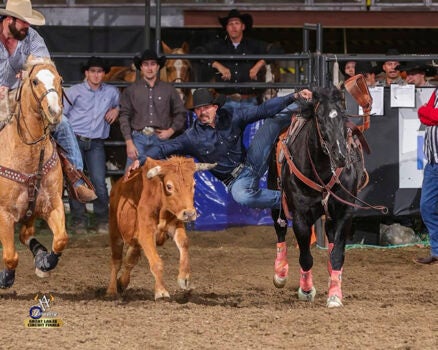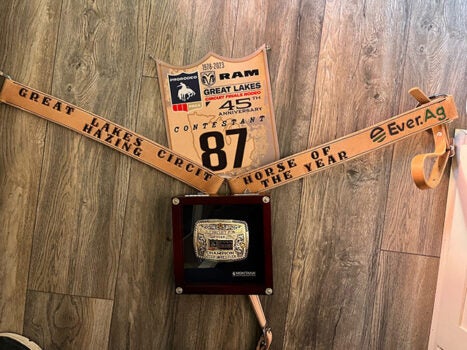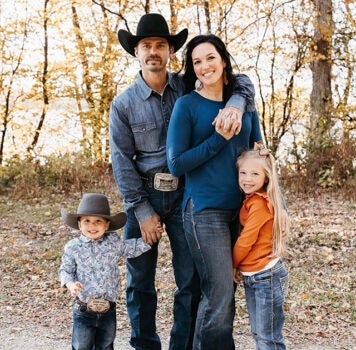Third-generation rodeo competitor is all in
Published 3:00 pm Monday, February 26, 2024
|
Getting your Trinity Audio player ready...
|
By Kim Gooden for the Tribune
ALDEN — Growing up around rodeos had a strong influence on Chance Carlson, to the point that he began team roping when he was in fourth or fifth grade and began competing in sixth grade.
According to Carlson, roping is where a lot of people get started in rodeo.
But in his freshman year of high school, he was ready to tackle a new event — steer wrestling, also known as bulldogging.
It is a rodeo event in which a horse-mounted rider chases a steer, drops from the horse to the steer, then wrestles the steer to the ground by grabbing its horns and pulling it off-balance so that it falls to the ground.
“I started jumping steers off horses at the High School Rodeo that year,” Carlson said.
In 2002, he placed ninth in the nation in steer wrestling at the National High School Rodeo finals. In 2003, he won the year-end All-Around and the steer wrestling event at the High School Rodeo, and he won the steer wrestling event again in 2004.
Now, at age 38, he is a member of the Professional Rodeo Cowboy Association, and he is currently ranked 10th in the world standings in steer wrestling.
Being ranked is determined by how many rodeos a cowboy participates in and how much money he or she has won.
Carlson participates in the circuit system, and there are 12 circuits in the United States. He is in the Great Lakes circuit, which includes the states of Illinois, Indiana, Iowa, Kentucky, Michigan, Minnesota, Missouri, Ohio and Wisconsin.
To be eligible for circuit finals, participants must compete in at least 15 rodeos within their circuit. However, they can also compete in rodeos in other circuits, and everything they earn, in and out of their circuit, is applied toward their world standings. If they end up in the top 15, they will qualify for the Wrangler National Finals Rodeo in Las Vegas.
In 2021, Carlson won the Year-End in steer wrestling at the circuit finals, which qualified him to compete in the National Finals Rodeo Open in Colorado Springs, Colorado.
In 2023, Carlson won the Average in steer wrestling at the circuit finals, which qualified him to compete in the NFR Open again this year.
Carlson said there is not much likelihood of him making it to Las Vegas.
“The rodeo season runs from Oct. 1 through Sept. 30, and from the end of May through September we are gone almost every Thursday through Saturday competing in at least two, and up to five, rodeos in a weekend.
“It takes too much,” he said. “I don’t have the freedom to go rodeo full-time because I’ve got to keep my job and pay the bills.”
Carlson’s main job is working as a farrier. He shoes and trims horses’ hooves in an area that extends from Butterfield to Hayfield in Minnesota and south to Garner and Spencer in Iowa.
But he considers rodeo a second job.
“I come home and I work at it. When I go to a rodeo I want to win, I don’t go to have fun,” he said. “The last few years I’ve made between $10,000 and $13,000 in steer wrestling. It’s a decent second job.”
And when another cowboy rides one of his horses, he gets 25% of their winnings.
Carlson hauls two horses to the rodeos he participates in. Black Cat, the horse he rides, is the dogging horse. The other horse, named Bronsin, is the hazing horse, and it’s his job is to keep the steer running straight.
Bronsin was named Great Lakes Circuit Hazing Horse of the Year in 2023.
Carlson explained that the longevity of a horse depends on the horse.
“It’s not so much hard on the horses physically as it is mentally, because we ask so much of them from what we call the corner of the box to the line. The starts in bulldogging are very fast, and then those horses have to run by. It has a tendency to what we refer to as “fry them mentally” because it’s a lot of pressure.”
He compared it to the pressure that any athlete is under and whether they can handle it.
“I’ve had horses that lasted for 20 steers,” he recalled. “But my hazing horse was my bulldogging horse for 10-11 years, and he’s 23 years old now and still wants to go every day.”
Both the dogging horse and the hazing horse are equally challenged in the arena.
“The hazing horse has to be ready when the bulldogger nods, and has to work just as hard or harder than the dogging horse because he may be behind from the start,” Carlson said.
Steer wrestling can also be hard on the steer wrestler as it is very hard on their knees.
“A lot of guys have blown their knees out. And the older you get, the harder you have to work, because your body just doesn’t react as quickly as it used to,” he said.
It can also carry a risk of injury.
“You are jumping off a horse that is going 20 to 30 miles per hour, onto a steer that is either going that fast or wanting to stop,” he said. “It can be dangerous.”
While a few steer wrestlers compete into their 40s, Carlson said he is getting on the old side of it.
In the meantime, Carlson continues to practice and train at home in the arena they put up a couple of years ago.
Depending on the weather, at the end of March or early April they will get steers, and then they’ll be in the arena almost every day.
Sometimes he will run steers on the ground without a horse by letting a steer out of the chute and running alongside it until he can throw it on the ground.
Sometimes they do what they call “score” to condition the horses to stay in the box, flat-footed, so they learn that not every time is a pressure situation.
When Carlson is practicing at home he is often assisted by his wife, Brittany, who rides the hazing horse, and his daughter, Kenlee, who lets the steers out of the chute. His son, Kasen, is too young to help but he is always nearby, watching.
Brittany also competes at some of the rodeos in the breakaway roping events.
Carlson is the third generation of rodeo competitors in his family, which began with his grandfather, Ken Carlson. If his children decide to make it a fourth generation, he will support them, but he will not push it.
“It’s something you either want to do or you don’t,” he said. “You can’t be half in or you won’t have any success.”







